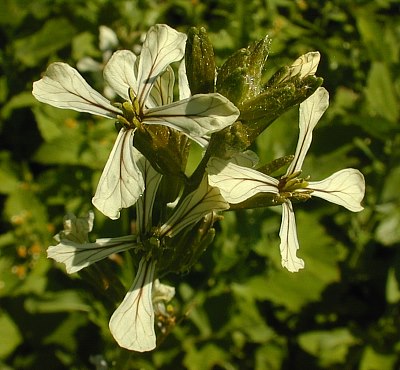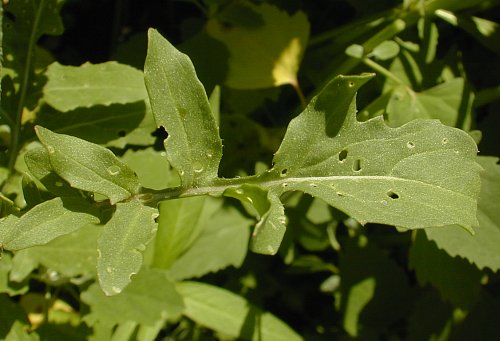
The upper stems terminate in racemes of flowers up to 6" long. The flowers bloom toward the apex of each raceme, while narrow seedpods (siliques) develop below. Each flower spans about ¾" across, consisting of 4 widely spreading petals, 4 narrow sepals, 6 stamens, and a pistil with a single style. The petals are are white with conspicuous veins that are purple or brown; they are oblanceolate to obovate in shape. The sepals are medium green (or olive green) to purple and linear-oblong in shape; they are often hairy. The blooming period usually occurs during the summer for 1-2 months. The flowers are replaced by cylindrical seedpods that become ½-1¼" long at maturity. Relative to the central axis of the raceme, they are held erect. The pedicels of the seedpods are rather short, but stout, curving upward; they are about ¼" in length. The seedpods terminate in prominent flattened beaks; their exteriors are hairless. Each seedpod contains 2 rows of seeds. Individual seeds are about 2 mm. in length. The root system consists of a short taproot.
Cultivation: The preference is full sun, mesic to dry-mesic conditions, and fertile loam, although other soil types are tolerated.

Range & Habitat: The introduced Garden Rocket rarely naturalizes in Illinois. So far, naturalized plants have been collected only in Peoria County (see Distribution Map). It has also naturalized in other states. Garden Rocket was introduced into the United States from the Mediterranean area of Europe as a salad vegetable. It may have been introduced even earlier as a contaminant of imported grain. Habitats of naturalized plants include cropland, fallow fields, roadsides, areas along railroads, and areas around vegetable gardens where this plant is cultivated. Disturbed areas with exposed soil are preferred.
Faunal Associations: The flowers are cross-pollinated by bees and possibly other insects. Two flea beetles, Phyllotreta cruciferae and Phyllotreta striolata, are known to feed on Garden Rocket. Because its foliage is quite peppery from the presence of mustard oils, this plant is probably eaten by mammalian herbivores only when little else is available.

Photographic Location: A vegetable garden at Meadowbrook Park in Urbana, Illinois.
Comments: Because of the dark veins on the petals, the flowers of Garden Rocket are quite distinct in appearance, and they are rather large in size for species in the Mustard family. On this basis alone, Garden Rocket can be distinguished from similar plants in Illinois. The cylindrical seedpods (siliques) of Garden Rocket are also rather unusual in having prominent flattened beaks. Other common names of this plant include Rocket, Roquette, Salad Rocket, and Arugula. A scientific synonym is Eruca sativa. This plant is still cultivated in North America as a salad vegetable, where it is used in fresh mixed greens. The leaves impart a flavor that is spicy and peppery, and they have relatively high levels of Vitamin C and potassium.